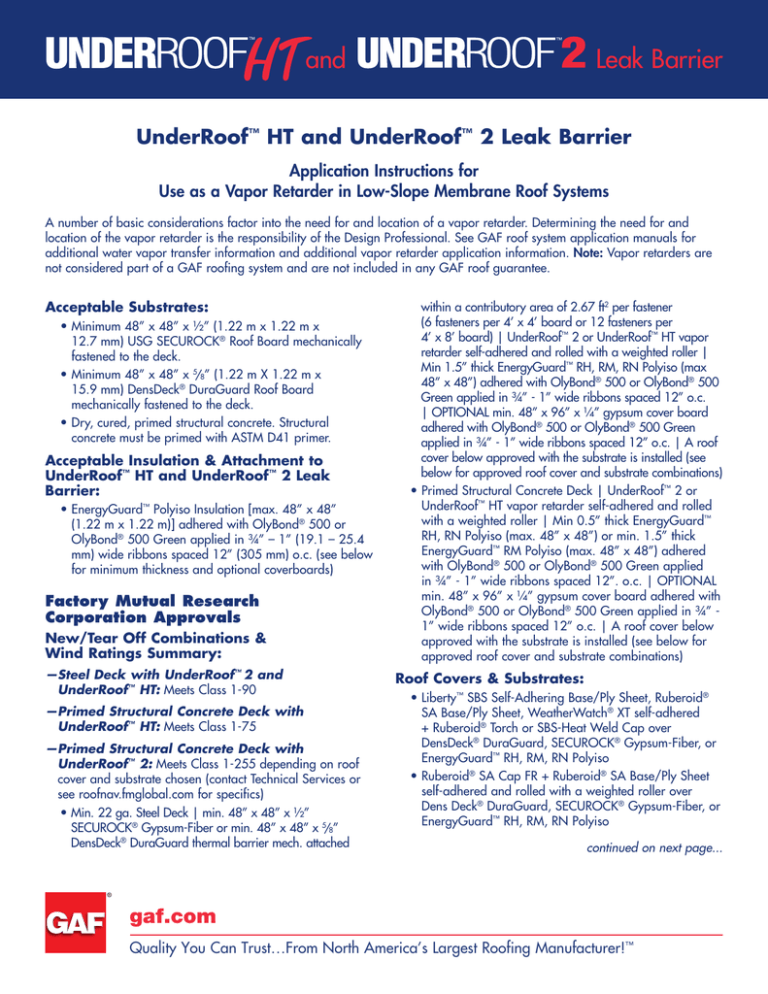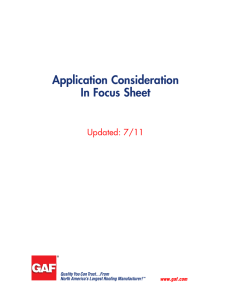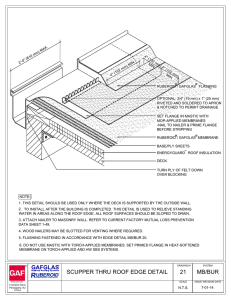HT and Leak Barrier
advertisement

and Leak Barrier UnderRoof™ HT and UnderRoof™ 2 Leak Barrier Application Instructions for Use as a Vapor Retarder in Low-Slope Membrane Roof Systems A number of basic considerations factor into the need for and location of a vapor retarder. Determining the need for and location of the vapor retarder is the responsibility of the Design Professional. See GAF roof system application manuals for additional water vapor transfer information and additional vapor retarder application information. Note: Vapor retarders are not considered part of a GAF roofing system and are not included in any GAF roof guarantee. Acceptable Substrates: •M inimum 48” x 48” x ½” (1.22 m x 1.22 m x 12.7 mm) USG SECUROCK® Roof Board mechanically fastened to the deck. • Minimum 48” x 48” x 5/8” (1.22 m X 1.22 m x 15.9 mm) DensDeck® DuraGuard Roof Board mechanically fastened to the deck. • Dry, cured, primed structural concrete. Structural concrete must be primed with ASTM D41 primer. Acceptable Insulation & Attachment to UnderRoof™ HT and UnderRoof™ 2 Leak Barrier: •E nergyGuard™ Polyiso Insulation [max. 48” x 48” (1.22 m x 1.22 m)] adhered with OlyBond® 500 or OlyBond® 500 Green applied in ¾” – 1” (19.1 – 25.4 mm) wide ribbons spaced 12” (305 mm) o.c. (see below for minimum thickness and optional coverboards) Factory Mutual Research Corporation Approvals New/Tear Off Combinations & Wind Ratings Summary: —Steel Deck with UnderRoof™ 2 and UnderRoof™ HT: Meets Class 1-90 —Primed Structural Concrete Deck with UnderRoof™ HT: Meets Class 1-75 ­—P rimed Structural Concrete Deck with UnderRoof™ 2: Meets Class 1-255 depending on roof cover and substrate chosen (contact Technical Services or see roofnav.fmglobal.com for specifics) • Min. 22 ga. Steel Deck | min. 48” x 48” x ½” SECUROCK® Gypsum-Fiber or min. 48” x 48” x 5/8” DensDeck® DuraGuard thermal barrier mech. attached within a contributory area of 2.67 ft2 per fastener (6 fasteners per 4’ x 4’ board or 12 fasteners per 4’ x 8’ board) | UnderRoof™ 2 or UnderRoof™ HT vapor retarder self-adhered and rolled with a weighted roller | Min 1.5” thick EnergyGuard™ RH, RM, RN Polyiso (max 48” x 48”) adhered with OlyBond® 500 or OlyBond® 500 Green applied in ¾” - 1” wide ribbons spaced 12” o.c. | OPTIONAL min. 48” x 96” x ¼” gypsum cover board adhered with OlyBond® 500 or OlyBond® 500 Green applied in ¾” - 1” wide ribbons spaced 12” o.c. | A roof cover below approved with the substrate is installed (see below for approved roof cover and substrate combinations) • Primed Structural Concrete Deck | UnderRoof™ 2 or UnderRoof™ HT vapor retarder self-adhered and rolled with a weighted roller | Min 0.5” thick EnergyGuard™ RH, RN Polyiso (max. 48” x 48”) or min. 1.5” thick EnergyGuard™ RM Polyiso (max. 48” x 48”) adhered with OlyBond® 500 or OlyBond® 500 Green applied in ¾” - 1” wide ribbons spaced 12”. o.c. | OPTIONAL min. 48” x 96” x ¼” gypsum cover board adhered with OlyBond® 500 or OlyBond® 500 Green applied in ¾” 1” wide ribbons spaced 12” o.c. | A roof cover below approved with the substrate is installed (see below for approved roof cover and substrate combinations) Roof Covers & Substrates: • L iberty™ SBS Self-Adhering Base/Ply Sheet, Ruberoid® SA Base/Ply Sheet, WeatherWatch® XT self-adhered + Ruberoid® Torch or SBS-Heat Weld Cap over DensDeck® DuraGuard, SECUROCK® Gypsum-Fiber, or EnergyGuard™ RH, RM, RN Polyiso • Ruberoid® SA Cap FR + Ruberoid® SA Base/Ply Sheet self-adhered and rolled with a weighted roller over Dens Deck® DuraGuard, SECUROCK® Gypsum-Fiber, or EnergyGuard™ RH, RM, RN Polyiso continued on next page... gaf.com Quality You Can Trust…From North America’s Largest Roofing Manufacturer!™ and Leak Barrier …continued from previous page •E verGuard® TPO (smooth) fully adhered with EverGuard® WB 181, EverGuard® TPO #1121, or EverGuard® Low VOC TPO Bonding Adhesive over DensDeck® Prime, SECUROCK® Gypsum-Fiber, or EnergyGuard™ RH, RM, RN Polyiso • EverGuard® TPO FB Ultra fully adhered with EverGuard® WB 181 Bonding Adhesive over DensDeck® Prime, SECUROCK® Gypsum-Fiber, or EnergyGuard™ RH, RM, RN Polyiso • EverGuard® TPO FB Ultra adhered with LRF Adhesive O applied in ¾” - 1” wide ribbons spaced 12”. o.c. over DensDeck® Prime, SECUROCK® Gypsum-Fiber, or EnergyGuard™ RH, RM, RN Polyiso • EverGuard® Freedom™ TPO HW or EverGuard® Freedom™ TPO with RapidSeam™ Technology self-adhered over DensDeck® DuraGuard, SECUROCK® Gypsum-Fiber, or EnergyGuard™ RM, RN Polyiso What to do before you begin… 1. C heck the temperature… install only when the outside temperature is 45ºF (7ºC) and rising. In cool weather membrane rolls and adhesives must be stored overnight at a minimum temperature of 55°F (12.8°C) prior to their application. Remove all rolls from the heated storage only as they are being installed. Install membrane rolls immediately after removal from storage to avoid membrane cooling. Leak barrier rolls must be at least 45°F (7.2°C) at time of application. 2. Examine the deck or substrate… make sure the surface is clean, dry, and free of sharp edges. Any ice, dew, water, debris, dirt, oil, grease, or other contaminates will interfere with adhesion and may lead to a leak. 3. Examine the substrate for defects… repair where necessary. 4. Leave the release liner in place… until you are ready to adhere the vapor retarder to the deck or substrate. 5. Do not use UnderRoof™ HT or UnderRoof™ 2 Leak Barrier self-adhering vapor retarders as a temporary roof… in commercial/low-slope applications. 6. Safety note… any time installation takes you near the edge of the roof, use special safety precautions. Refer to your company safety manual for guidelines. Field Sheet Installation… First Course 1. S tart at the low point or drains… so the flow of water is over or parallel to the laps, but never against the laps. To aid in handling and sheet alignment and to minimize wrinkling, the membrane may be cut into a workable length [approximately 10’ - 20’ (3 - 6 m)]. Install the sheets perpendicular to the slope. Fold the membrane over lengthwise and remove the release liner from half the sheet and roll in the sheet. 2. Proceed to the other half… of the first sheet. Fold over the other half of the sheet lengthwise. Use care to keep the sheet straight. 3. Peel the release film… from this half of the sheet. It peels easiest when pulled at a 45º angle along the length of the sheet. Avoid touching the adhesive as you remove the film, as it is very aggressive. 4. Roll in this half of the membrane… keeping the sheet rounded as it adheres to the substrate. Once the entire sheet is installed, roll the sheet with a weighted roller to assure proper adhesion. 5. Work carefully… if the membrane runs off of the proper alignment by more than ¼” (6 mm), cut and restart the membrane installation. Field Sheet Installation… End Laps ­—For UnderRoof™ HT Leak Barrier end laps: 1. Align the new sheet… so that it overlaps the previous sheet 6” (152 mm). 2. After removing the release film… firmly roll the end lap with a silicone-coated hand roller to ensure sealing. —For UnderRoof™ 2 Leak Barrier end laps: 1. Align the new sheet… so that it overlaps the previous sheet 6” (152 mm). 2. A t the overlap… fold the sheet back to a point 12” (304 mm) from the end of the roll. 3. S core the release liner… leaving the 12” (304 mm) section in place. Be sure to score the release liner of the selvedge edge at the same point. 4. Install the balance… of the membrane as you normally would. continued on next page... gaf.com Quality You Can Trust…From North America’s Largest Roofing Manufacturer!™ and Leak Barrier …continued from previous page 5. R eturn to the end lap area… and fold back that portion of the membrane where the release liner is still in place. 6. A pply TOPCOAT® Matrix™ MajorBond™ Flashing Cement or TOPCOAT® Matrix™ Premium 201 SBS Flashing Cement… in the 6” (152 mm) area of the bottom sheet forming the end lap. Trowel to an even thickness approximately 1/16” (2 mm) to 1 /8” (3 mm) thick. 7. T o complete the end lap… remove the release film from the back of the top sheet, the 12” (304 mm) piece left in place in previous step. Set the top sheet into adhesive and firmly roll the sheet with a silicone-coated roller to ensure sealing. Field Sheet Installation… Subsequent Courses 1. P osition subsequent courses… using the selvedge edge line to align the membrane. —UnderRoof™ HT Leak Barrier requires a minimum 3” (72 mm) side lap. —UnderRoof™ 2 Leak Barrier requires a minimum 4” (102 mm) side lap. 2. B e sure… to firmly roll the lap area with a siliconecoated hand roller at the end to ensure sealing. Seal all roof edges and penetrations •A ll roof edges and penetrations must be sealed to retard moisture vapor migration at these locations. If UnderRoof™ HT or UnderRoof™ 2 Leak Barrier is to be adhered to concrete or metal surfaces, the surfaces must be primed with ASTM D41 primer and allowed to dry. Firmly roll the sheet with a silicone-coated roller to ensure adhesion. Precautionary Note: The application of this product or the roof system may require the use of adhesives or cements that contain solvents. Apply these adhesives/ cements ONLY as instructed. Application of excess solvent-based adhesives or cements may affect the performance of this product, resulting in the asphalt flowing, dripping, and staining. gaf.com Quality You Can Trust…From North America’s Largest Roofing Manufacturer!™ ©2013 GAF 1/13 • #808 • 1361 Alps Road, Wayne, NJ 07470




